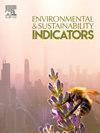Evaluating the effectiveness of the ecological redline policy in conserving mangroves via assessment on coverage and carbon storage
IF 5.4
Q1 ENVIRONMENTAL SCIENCES
引用次数: 0
Abstract
Mangrove ecosystems are famed for their crucial ecological functionalities in moderating global carbon cycling process. To safeguard these ecosystems, the Chinese government implemented the Ecological Redline Policy (ERP) in 2017. This study evaluated the effectiveness of ERP in protecting mangroves and enhancing their carbon storage potential using multi-temporal Landsat-8 OLI images via InVEST Carbon Storage and Sequestration model, and field surveys conducted in Guangdong Province, which hosts the largest mangrove distribution in China. The results revealed a total increase of 2094 ha in mangrove area, with approximately 65.2% of mangroves increase currently included in the ERP zoning plan. Within ERP zones, the mangrove increment was 1365.55 ha, with a lower expansion rate of 20.7% while the Non-ERP zones exhibited an increment of 729.32 ha at a higher expansion rate of 38.3%. Furthermore, around 80.0% of carbon storage in mangroves was managed within ERP zones, with no significant difference in carbon density between ERP and Non-ERP zones, though both groups showed an overall increase in carbon density by 2021 compared to 2013. It is suggested that the ERP zone not only enhances carbon storage but also improves other ecological traits of ecosystem. However, the current ERP appeared to fall short of fully meeting strategic needs, emphasizing the necessity of optimized planning to minimize tradeoffs between environmental quality and development.
通过对红树林覆盖和碳储量的评估来评价生态红线政策在保护红树林方面的有效性
红树林生态系统因其在调节全球碳循环过程中的重要生态功能而闻名。为了保护这些生态系统,中国政府于2017年实施了生态红线政策(ERP)。本研究利用InVEST碳储存与封存模型,利用多时相Landsat-8 OLI图像,并在中国红树林分布最广的广东省进行实地调查,评估了ERP在红树林保护和提高红树林碳储存潜力方面的有效性。结果表明,红树林总面积增加了2094 ha,其中约65.2%的红树林目前已纳入ERP分区计划。在ERP区域内,红树林的增长量为1365.55 ha,扩张率为20.7%,而非ERP区域的增长量为729.32 ha,扩张率为38.3%。此外,大约80.0%的红树林碳储量是在ERP区域内管理的,在ERP和非ERP区域之间的碳密度没有显著差异,尽管到2021年,这两个组的碳密度都比2013年有所增加。结果表明,ERP区不仅提高了生态系统的碳储量,而且改善了生态系统的其他生态性状。但是,目前的环境资源规划似乎没有充分满足战略需要,强调必须进行最佳规划,以尽量减少环境质量与发展之间的权衡。
本文章由计算机程序翻译,如有差异,请以英文原文为准。
求助全文
约1分钟内获得全文
求助全文
来源期刊

Environmental and Sustainability Indicators
Environmental Science-Environmental Science (miscellaneous)
CiteScore
7.80
自引率
2.30%
发文量
49
审稿时长
57 days
 求助内容:
求助内容: 应助结果提醒方式:
应助结果提醒方式:


